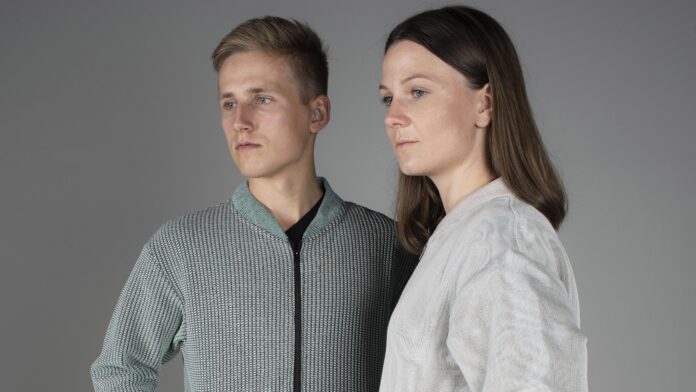“Revolutionizing Fashion: Aalto University Pioneers Invisible Solar-Powered Textiles for Energy-Autonomous Wearables”
In the rapidly evolving sphere of textiles and technology, the boundaries are continuously being pushed to bring forth innovative solutions that promise to change the way we interact with our garments. Enter the pioneering researchers at Finland’s Aalto University, who have developed a groundbreaking jacket that effectively blends fashion with function. Dubbed the “Sun-Powered Textiles” jacket, this futuristic piece of clothing houses concealed solar panels, designed ingeniously to remain invisible to the human eye while providing a sustainable energy source for powering wearable devices.

The brainchild of both design and physics researchers at Aalto University, the Sun-Powered Textiles project seeks to create energy-autonomous garments. The aim is clear: to power wearable devices such as humidity or temperature sensors embedded within the clothing fabric without compromising the aesthetics. Now, imagine a standard-looking piece of apparel that can charge devices and track environmental factors – that’s the magic of this innovation!
Shedding Light on Photovoltaics (PV)
Traditional photovoltaic cells, or solar cells, have presented significant challenges in their integration into textiles. These cells typically need to be mounted on the fabric’s surface to maximize energy harvesting, which often results in a less than pleasing aesthetic due to the conspicuous black cells that tend to dominate the garment’s appearance. However, the masterminds at Aalto University have redefined this integration process. They placed these solar cells beneath the textile surface, optimizing the fabric so that enough light could penetrate through to power the hidden cells. End result? A stylish, machine-washable jacket that conceals its high-tech prowess.
This innovative approach to textile technology merges advanced photovoltaic technology with traditional garment production. By concealing the solar cells and making them capable of enduring the usual wear and tear, including washing, Aalto University has opened new doors for smart textiles, particularly in safety, workwear, and sportswear applications.
Overcoming Hurdles and Innovating Integration
Design researcher Elina Ilen from the Aalto University team elucidates the intent and process behind this tech-forward invention. The integration of solar cells implies adjusting the cell type and surface area to match different fabrics, whether it be cotton, linen, viscose, polyester, or polyamide. By tweaking textile structure, density, color, and applying specific finishing treatments, the researchers optimized the fabric’s optical properties to permit sufficient light penetration.
If you’re a tech aficionado or a textile enthusiast, you know that smart textiles must also ensure durability and versatility. This jacket’s ability to convert energy from both natural and artificial light—albeit less efficiently from the latter—is a noteworthy step toward practical, daily-use applications. Conductive fibers within the jacket transfer the harvested solar energy to power the wearable sensor devices. These fibers are flexible and can even stretch, ensuring that the wearer’s comfort and the textile’s aesthetics remain uncompromised, while seamlessly integrating sophisticated technology.
Broader Applications and Industrial Collaboration
The pioneering accomplishment doesn’t just stop at clothing. The team envisions extending this groundbreaking technology to other textiles as well, like curtains or screens that can harness solar power, further expanding the practical applications of their invention. The concept fundamentally revolutionizes energy consumption in our everyday surroundings, making renewable energy more integrated and accessible.
A worthy mention goes to the collaborative nature of this venture. Industrial partners, Foxa and Lindström, contributed their textile expertise while electronics company Haltian provided the hardware and software necessary to transform the concept into reality. This collaborative synergy exemplifies how bringing together textile experts and technology developers can lead to groundbreaking advancements.
The prototype jacket, which power humidity and temperature sensors, demonstrates the potential practical uses for workers who are constantly on the move and can benefit from real-time environmental data without the hassle of recharging devices. Such innovations herald a new era of ‘smart clothing’ that not only adapts to wearer needs but also integrates seamlessly into the electric grid of our everyday routines.
Visions for the Future and Comparisons
The Sun-Powered Textiles project was showcased in Helsinki Design Week’s online exhibition “Designs for a Cooler Planet,” highlighting its potential to mitigate non-renewable energy reliance. If we draw comparisons, Dutch designer Pauline van Dongen’s Wearable Solar garments featured flaps that open to reveal solar panels, establishing a benchmark in the field of solar-integrated wearables. While Pauline’s approach is laudable, it leaves room for aesthetic compromises that Aalto’s innovation cleverly bypasses.
Van Dongen’s subsequent Radius backpack, which integrates tiny spherical solar cells into its fabric, draws a parallel to Aalto University’s near-invisible cell integration. Both innovations underscore a pivotal shift towards embedding renewable energy sources within personal items without significant deviations from conventional aesthetics.
The Sun-Powered Textiles Team: Behind the Innovation
Acknowledging the brilliant minds behind this creation, the Sun-Powered Textiles team comprises Elina Ilen, Janne Halme, Farid Elsehrawy, Elina Palovuori, Bettina Blomstedt, Pinja Helasuo, Jaakko Eskola, Zuzana Zmatekova, Linda Wederhorn, and Maarit Salolainen. Their collective effort spans design, physics, and engineering disciplines, underscoring the interdisciplinary collaboration necessary to bring such a nuanced innovation to life.
Bridging the gap between traditional textile expertise and cutting-edge photovoltaic technology represents a significant leap in smart textiles. The endeavor to create a garment that is not only visually appealing and practical but also tech-savvy enough to harvest and utilize renewable energy is a striking example of modern ingenuity.
Final Reflections and the Path Forward
The Sun-Powered Textiles initiative embodies what’s possible when creative design meets scientific rigor. The development of such an energy-autonomous garment heralds a future where the mundane act of wearing a jacket could contribute actively to our eco-friendly and sustainable lifestyles. Imagine walking through your day, with your attire silently working behind the scenes, harnessing sunlight to power essential wearables. This not only enhances convenience but also aligns with global sustainability goals, proving that we can indeed dress smartly and sustainably.
As the field of textile technology continues to evolve, the innovations seen at Aalto University provide a clear signal that smart textiles have a promising and bright future. The marriage of form and function, as evidenced by these sun-powered fabrics, opens a plethora of possibilities for consumer apparel, professional gear, and beyond. The protective clothing market, in particular, is poised to benefit significantly, offering workers not only safety but also enhanced functionality through integrated tech solutions.
With the relentless advancement of solar technology and its ingenious incorporation into textiles, we are not far from a time when energy-autonomous clothing will become a staple in our wardrobes. Textile Topher will be here to keep you updated on each pioneering step forward, showcasing the future as it weaves into our daily lives, one thread of sunlight at a time. Keep your eyes peeled, dear readers, for this is just the beginning of a textile revolution!
Keywords: Smart Textiles, Solar Panels, Aalto University, (Post number: 71), Renewable Energy, Wearable Devices





